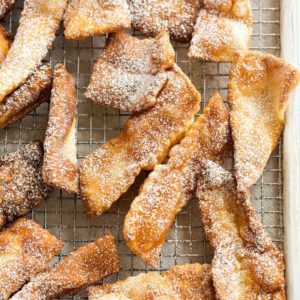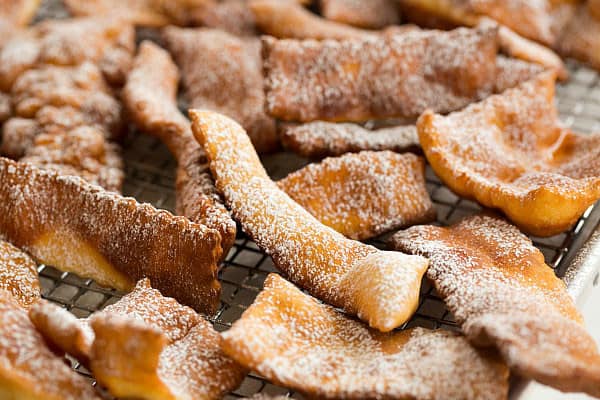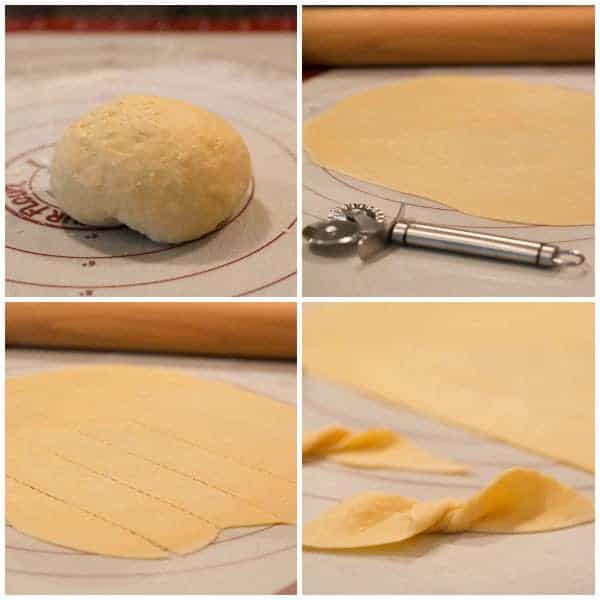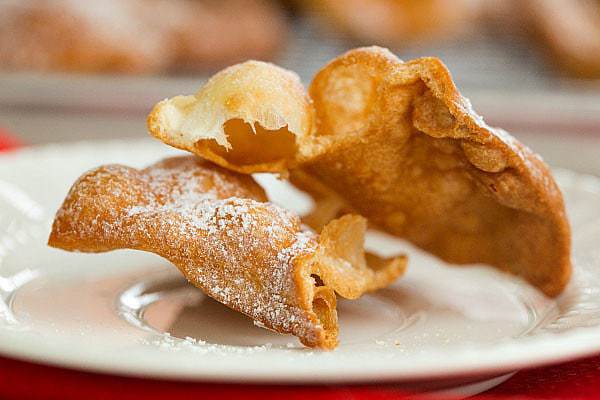Grandma’s Fried Dough Pastries
Growing up, our family had the same routine every year on Good Friday – we would go to church in the afternoon, go home and relax, then head over to my grandma’s around dinnertime. Her kitchen would be overflowing with her usual Easter fare – pigu, bacon and cheese bread, and this fried dough. The bacon and cheese bread was off-limits until the following day since it had meat, but everything else was fair game. We’d usually order a cheese pizza and then hunker down to watch a movie. Sometimes it was Easter-related, but I distinctly remember one year watching Stephen King’s The Stand. That turned into an entire weekend event and some crazy dreams!
I can remember a huge tray piled high with this fried dough sitting out in her kitchen, and then again at my mom’s on Easter Day. My grandma only ever made it for Easter, and I would waste no time devouring this once-a-year treat.
I don’t remember my grandma making these very often since I was in high school, which may have had to do with her hands becoming weaker. The dough is kneaded and rolled out by hand, and it’s a very stiff dough, which means that it takes some elbow grease! I’m sure you could use a stand mixer to knead it and even a pasta roller to roll it out if you’d like, but I went the traditional method and did everything by hand.
I recall my grandma’s pastries being twisted into little bow-tie shapes. I tried to do it, but they came unraveled while frying and just ended up a little twisted. I wish I could ask her how she did it! We always referred to these as “fried bow ties”.
My grandma served these sprinkled with powdered sugar, which was just the perfect amount of sweetness to balance out the flavors of the fried dough. My husband’s family makes a very similar recipe, only instead of Easter they serve it on New Year’s Day, and in addition to sprinkling it with powdered sugar, they also dip the fried dough in honey.
You know that old family recipes are my favorites, so I was thrilled to finally make my grandma’s fried pastries. An Easter tradition revived!


Grandma's Fried Dough Pastries
- 3 cups (375 g) all-purpose flour
- ½ teaspoon (0.5 teaspoon) baking powder
- ½ teaspoon (0.5 teaspoon) salt
- 4 eggs
- 1 tablespoon vegetable or olive oil
- ¼ teaspoon (0.25 teaspoon) anise oil
- Peanut or vegetable oil, for frying
- Powdered sugar, for dusting
- In a medium bowl, sift together the flour, baking powder and salt; set aside.
- In a large bowl, lightly beat the eggs. Stir in the oil and anise flavoring and beat or whisk to combine.3. Gradually add the flour, mixing until the dough is stiff enough to be turned out of the bowl.
- Turn the dough out onto a lightly floured surface and knead until the dough is smooth and pliable, kneading in any remaining flour mixture. Shape into a ball and divide into quarters. Wrap each tightly in plastic wrap and let rest for 30 minutes.
- Meanwhile, fill a wide pan (I used a cast iron skillet - you could also use a Dutch oven) with at least one inch of oil and place over medium-high heat. The oil is hot enough when a little piece of dough dropped into the oil sizzles immediately.
- Working with one portion of dough at a time and keeping the remainders covered, roll it out as thinly as possible and cut into 1½ to 2-inch wide strips. You can twist the dough, if you'd like. Drop the pieces of dough into the oil, being sure not to overcrowd the pan. Fry until light brown on the bottom side (1 to 2 minutes), then turn over and fry until the other side is also light golden brown. Remove to a wire rack placed over a double layer of paper towels and allow to drain. Repeat with the remaining dough. Dust with powdered sugar and serve. These can be made up to a week in advance and stored at room temperature in a tin or airtight container.
Did you make this recipe?
Leave a review below, then snap a picture and tag @thebrowneyedbaker on Instagram so I can see it!










My Nornie and Mom used to make these. Nornie was from Milan and made them without a written recipe. I haven’t had them in a LONG time. I’m so happy to see this recipe. I can’t wait to try it out.
Whenever I find them in the grocery store I purchase them (or think about it). Sadly, they always taste/smell like the plastic packaging they come in. So sad.
Josie Guild again – forgot to mention … my family called this Lattuga or sometimes lettuce leaves.
We are Polish and call them kluschicki and is a Christmas tradition.
Appreciate the nutritional info bu what is “one serving”? Can you be more specific? Grams? Ounces? I am baking for elderly friends so fat and carbs are important to them.
Thank you.
My mom was full blood Norwegian. They all made treats like these, usually at Christmas, called Fattigmans Bakels. Fried dough, with a slit in the middle, and dusted with powdered sugar. Always looked forward to them.
I make these every year but our tradition is for Christmas ! I make some that are bow ties with powdered sugar and a different shape for honey and walnuts on top. Everyone loves these! They are worth the work! Our family calls them cruspellI. However, We do not add the anise oil. Maybe I’ll start a new tradition and start making them for Easter as well as once a year is not enough!
Was happy to find your recipe. Our family called them “Keglies”. The recipe was about 50 years old and had many revisions. Your recipe is great. I dip in granulated sugar and love them for snacks. Thanks again.
To make the bowtie shape–our grandmother cut the rolled dough into diamond shapes. Then cut a slit about an inch long in the middle of the each diamond. To make the bow tie shape, just pull the points, one at a time, thru the slit, ending pointed in the same direction as they started. This bowtie shouldn’t unravel.
The name of this herishtula.
After cutting into strips, make a cut down the middle leaving both ends uncut. You take one end thru the whole in the middle. They will stay together during frying. Good Luck and thank you
Hi, Im from the Azores( Portuguese Islands) and we have versions of this in differentvshapes and sizes! Loving all the feed back of various traditions and cultures! Have a question, does it have to be “oil”? Can it be a hint of orange or lemon zest? Vanolla/ almond extract, some recipees even have whiskey or cherry or marsala!
maria
My family is Croatian and we make these all the time. They are called Chrustulini and can last quite a while in a tin. We don’t fry them as dark as above & they get nice & puffy. We do the slit + twist to form bow ties.
They are on every dessert table year round – yum!
My Nonna was from the Veneto region, and they called these “crustoli” in their dialect. Thank goodness you included the anise oil – they just don’t taste right without it. Now that her generation is gone, there are so few who remember how to make them. I need some lessons from my sister-in-law!
Hi Michelle, I am Polish and I know these pastries very well. They are called faworki or chrust and the bow ties are super easy to make as I see in the comments already, just cut a slit in the middle with a pizza cutter and fold the dough through the slit. These are my favorite pastries of all time and my family would also make them around Easter.
It’s so great to make recipes that remind us of our loved ones! Such a simple, yet classic recipe.
My Mom made these once a year and I have always loved them. She called them Bird’s Nests and piled them high and sprinkled with lots of powdered sugar. Thanks for the recipe, I am going to try it soon. Love your blog, many goodies to eat.
Pop: you’re absolutely right! These are faworki (or, like you say, chrust/chruściki, depending on the region). They are a beloved Polish carnival pastry and we eat them by the bucketloads on Shrove Thursday. The only difference is that we don’t add any baking powder or other baking agents into the dough, because good faworki should be paper-thin and crispy. Also, according to traditional recipes, the dough should not only be well-kneaded, but bashed against the pastry board, until bubbles of air show inside. That’s hard work :D
My Italian family called these pastries “crostoli” but there’s about a dozen different names for them across Italy. And they were made at Christmas and Easter. My nonna made them with both honey and just powdered sugar but sometimes with an apricot glaze — amazingly yummy. And not to leave the Scandinavians out, when that part of my family made pie, leftover crust scraps (rags) were sprinkled with cinnamon sugar and baked. And the kids got cookies!
I think they may be shaped like Polish Chrusciki, “…In each strip, cut a one-inch slit the long way, in the middle of the strip. Pull one end of the strip through the slit so that it looks kind of like a bowtie.” I vaguely remember my mother making these, but it was many years ago.
My family loves fried dough. Pinned it! ♥
If you have time to party, I would love it if you’d come to my Wonderful Wednesday Blog Hop to share some posts :)
I think I remember my mother cutting a slit in on end but leaving the end closed. Then you pull the other in through and back to look like a bow. I love these treats.
I love fried dough!!
where dies one purchase anise oil, or is anise flavoring comparable.
Hi Monica, You can sometimes find it with other oils at a pharmacy counter. I’ve also purchased mine at a local Italian grocery store and online from King Arthur Flour.
Wow they look like my aunts used to make Christmas time we call them crostoli and they shapped them into a spiral once done we pour warm honey yum yum now I am going to have to make some. Been a busy pre Easter cooking time so far, half italian married to an italian with a large family. May make them for sunday
Happy Easter to you all and all your followers
In my childhood Polish neighborhood, these were called chruściki (probably lots of different spellings) but more commonly known as Angel Wings amongst us kids. Thanks for sharing and bringing back those memories.
That’s what we called them too! We had Angel Wings for every special occasion – weddings, baptisms, 1st Communions. The Polish bakeries in Hamtramck would sell these and I haven’t been able to find them since I moved away. Thank you so much for this recipe, I’ve always wanted to try making them!
Asians have a version of this too, usually made for Chinese New Year. And it was twisted in the way that Randy suggested at the top of the comment list. I find it fascinating how different cultures all over the globe have versions of the same item, an example would be perogies which of course are dumplings in Asia and I know Russia has their own version too.
My Hungarian Grandma made a savory version – fried bread dough, sprinkled with salt. She lived over the border in Ohio. Brings back memories.
I should have eaten lunch before reading this post! I have never had anything like this in my family. They look amazing! Who doesn’t love some fried dough with sugar?!?!?!
Those look so delicious, but then, fried dough generally is! :) Such a special Easter treat!
In Mexico called SOPAIPILLAS. I think evry country have your own recipe. Thanks for sharing.
OMG!!! As kids, my mom made these too. “We” called them Kluschicki (spelling??) and they were fried in a cast iron skillet too and drained on a brown paper bag. My gramdma, I never had the pleasure to meet did it this way, so “old school” and my mom still insists its done this way. We then dropped them in a bag with powdered sugar and gently shook them. I remember just eating away. Thanks for posting this ..may have to make a batch!
My parents came from the Ukraine many years ago. My mom made these for us a couple of times a year. I have forgotten the Ukrainian name for them. Mom made the parallel “slit” in the dough. It was my job, as a little girl, to carefully pull an end through to the other side and place them on a clean dish towel. Then she would deep fry her “Twisties”. I would then put them in a paper bag filled with confectioner’s sugar and shake it carefully to cover the Twisties.
Karen, I too grew up with these fried dough, but I am Mennonite with German relatives coming from the Ukraine region too. These were called RullKuchen, we always ate them with Watermelon (and watermelon syrup in the old days). The slit in the middle is exactly how the bow tie look would be made. It’s fun to see other people enjoying my “comfort” food!
My mother was Portuguese. She used to make these at Easter. She has passed on and unfortunately, this was one of her recipes that I never got on paper. The other one I am still looking for is pineapple squares dusted in powered sugar. Bless you for this recipe.
A dear Portuguese friend of mine makes something very similar to these. They usually are made for special occasions…so delicious.
My grandma makes a similar treat, but only once a year on my dad’s birthday. These are perfect for any celebration. That’s too funny that you watched “The Stand” on Good Friday. I don’t really remember there being many Easter movies.
These look great BEB! You could even dip them in chocolate…..oooohhhh that would be soooo delicious {just wiped my mouth, its watering :)}
The trick to the twisted shape is to cut a slit in the center of the rectangle, parallel to the long edge. You then fold one end of the rectangle, using the short edge, through the slit, twisting the sides of the slit as you do. That twist will hold its shape.
Love this tip!
That’s how my husband’s family does it in his Polish family. I’m not sure of his recipe, but his are teeny tiny and are light as air. Sometimes, for time, he’ll make them bigger so he has to fry less,
That’s how my family did it. We called them fried rags, which was the translation from Italian.
That’s how we do it too!